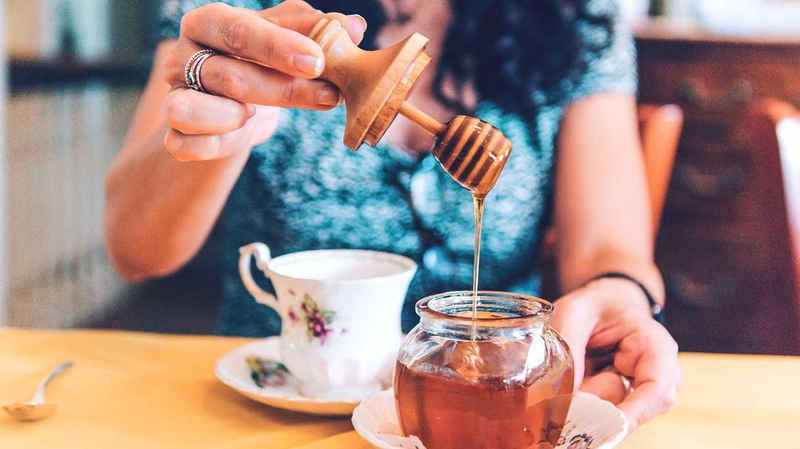Raw honey is a great source of antioxidants and other nutrients; it also has antifungal, antibacterial, and anti-allergenic properties. Among many of its benefits, one is to help you feel better when suffering from seasonal allergy. While there is no real scientific evidence to support the benefits of honey to combat seasonal allergy, the practice of consuming it to diminish allergy symptoms has make it a popular natural remedy. It is thought that bees collect pollen from the environment while gathering nectar from flowers, which means that you can consume honey to get a safe amount of pollen to condition yourself to it. But here comes the question "How much honey for allergies will really make a difference?" “Are there any risks involved in this practice?” Let's find out more about it.

What Kind of Honey for Treating Allergies?
You need to understand that when you talk about treating allergies with honey and wonder how much honey for allergies can work, you should not be going for those jars of honey you find at the supermarket. You will have to find local, unprocessed honey to treat allergies. Just keep in mind that raw honey can have some nasty stuff in it, including mold spores, bee parts, and even bacteria.
It is therefore a better idea to opt for locally farmed raw honey. However, you should always avoid processed honey because it may not contain enough pollen to create any effect on your allergies. If you cannot find any bee farms in your local area, you can simple get raw honey from somewhere else. Here are a few tips to consider:
Be sure to visit natural food stores and local farmers markets to see if you can get locally sourced honey. You can also go online to find the nearest bee farm.
Try to get information about which pollen triggers your allergic reaction, and then you can shop outside your area so long as you know it has been obtained from the same types of plants that grow in your area.
Search for the bee farm that is closest to your location, especially if you are not too sure about which pollen makes you deal with an allergic reaction.
How Much Local Honey for Allergies
Suppose that you have obtained local raw honey and now want to use it to treat your allergies. You may be wondering how much honey for allergies will make a difference. Well, you should start with smaller doses. The idea is to provide your body with a safe amount of pollen everyday so it could develop a tolerance against it. It is okay to take a tablespoon of honey daily, but do not take too much too early or you may actually make you allergies worse. Here are a few tips to consider:
You can consume a tablespoon of honey once a day. Instead of taking it by itself, you can also take it with foods. Apply it to a toast and enjoy!
Avoid using honey when cooking or baking something. You need a specific amount of pollen to treat your allergies, but heat can destroy the pollen in it the honey.
You can add honey to a hot beverage to enjoy its benefits – it works because the beverage is less likely to be hot enough to destroy the pollen.
Limitations and Risks of Using Local Honey for Allergies
Do Not Rely Too Much on Honey
There is no scientific evidence to confirm that honey works for allergies. Some people notice no change in their symptoms, while others find some relief. Just be sure to keep your allergy medication around in case your symptoms become worse.
Do Not Expect Too Much of Offending Pollen in Honey
You may be thinking that you are consuming honey to expose your body and immune system to a safe amount of pollen, but that may not be the case. Sometimes, there is little to no amount of pollen in the honey that you are consuming, so it can't make a substantial influence on your allergy symptoms – and this is especially true in case you are allergic to grasses, weeds, or trees.
Be Ready to Get More Than Just Honey
This is true in case you opt for raw honey, which has not been heated, pasteurized, or filtered. There may be mold spores, and bacteria, as well as venom and body parts of bees. Be sure to avoid raw honey if you are allergic to bee stings.
Be Ready to See Your Symptoms Become Worse
It can happen when there is a concentrated amount of the pollen that you are allergic to in your local raw honey. You just cannot tell how much of pollen is there in raw honey, so you will develop an allergic reaction if you are extremely susceptible to even small traces of pollen. Stop using honey if you experience itching, swelling, or hives on your skin, in your throat, or in your mouth.
Never Give Honey to Children Under 12 Months
As mentioned, there can be many toxins and other substances in raw honey and your child's immune system is not yet developed enough to deal with those allergens and other toxins. Be sure to seek medical attention if you child has ingested honey and is experiencing problems like lack of appetite, constipation, weakened muscles, pronounced floppiness, feeble crying, listlessness, and a lack of strong facial expressions.
Trying Bee Pollen As an Alternative
Another great option to reduce the allergy symptoms is pollen. Raw honey is supposed to work for your allergy because it contains traces of pollen. However, you can skip honey and focus only on getting an adequate amount of pollen instead. Be sure to start slow because you can get an allergic reaction. If you do not experience issues like itchiness or redness around the eyes, you may take up to a teaspoon of pollen a day for a month to treat your seasonal allergy.
View All Comments /Add Comment